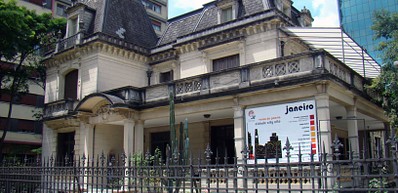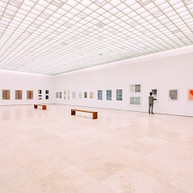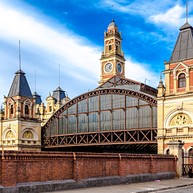
-
![Mosteiro de São Bento in São Paulo, Brazil]() Provided by: Patricia Figueira/cc by-sa 2.0/wikimedia (upscale)
Provided by: Patricia Figueira/cc by-sa 2.0/wikimedia (upscale) -
![Mosteiro de São Bento in São Paulo, Brazil]() Provided by: Halley Pacheco de Oliveira/cc by-sa 3.0/wikimedia
Provided by: Halley Pacheco de Oliveira/cc by-sa 3.0/wikimedia

Our travel guides are free to read and explore online. If you want to get your own copy, the full travel guide for this destination is available to you offline* to bring along anywhere or print for your trip.
*this will be downloaded as a PDF.Price
€4,95
Mosteiro de São Bento
The guide was updated:Founded by a monk named Mauro Teixeira in 1598, the incredible São Bento Monastery (St Benedict's Monastery) houses an enormous organ with about 6,000 pipes and an image of the Kasperovo Virgin covered with 6,000 pearls. Visit on a Sunday for the 10 am mass, complete with Gregorian chants from the monks.
Useful Information
- Address: Largo de São Bento, São Paulo
- Opening hours: Mon–Fri 6am–6pm; Sat 6am–1pm; Sun 7am–noon / 4:30pm–6pm
- Website: www.mosteirodesaobentosp.com.br
- Phone: +55 11 3328 8799
- Email: mosteiro@mosteiro.org.br
Digital Travel Guide Download
Our travel guides are free to read and explore online. If you want to get your own copy, the full travel guide for this destination is available to you offline* to bring along anywhere or print for your trip.
*this will be downloaded as a PDF.Price
€4,95

São Paulo's very own Central Park boasts over 2 million square meters of green space. The best way to explore it is to hire a bike. On Sunday mornings, there are free music concerts in the Praça da Paz. Here, you’ll also find a few interesting museums, such as the Museum of Modern Art, the exhibition hall OCA, and the Afro Brasil Museum.
Read more

Memorial da America Latina
The Latin America Memorial is a cultural centre designed by Oscar Niemeyer dedicated to Latin American folk art especially sculptures and paintings. Visit its website to see what’s on while you’re in town as it often hosts festivals, expositions, and food fairs.
Read more

Museu Afro Brasil
A museum dedicated to telling the story of Brazil's African-descended population, the largest outside Africa. Here you will find a vibrant and intelligent celebration of the culture and achievements of the African diaspora complete with plenty of art and some stunning photography exhibitions.
Read more

MAB FAAP — Museu de Arte Brasileira
A magnificent building in the trendy Higienópolis neighbourhood is the venue for major international exhibits held in the impressive Grand Hall and its wings. You will also find some of the big names of Brazilian art here including Portinari and Di Cavalcanti.
Read more

Museu de Arte Moderna de São Paulo (MAM)
The Museum of Modern Art located in Ibirapuera Park might be small, but it is one of São Paulo's best museums to see modern work by emerging and established artists. Here you will find everything from paintings and sculptures to video installations. Outside is a serene sculpture garden that is perfect for relaxing post-visit.
Read more

Pinacoteca
One of the best-curated art exhibitions in the city as well as one of the most important art museums in Brazil, Pinacoteca does an excellent job of displaying some of the best Brazilian artists from the 19th and 20th centuries. The centrepiece of the impressive collection of sculptures includes a statue by Raphael Galvez called "O Brasileiro".
Read more

Football Museum
The Soccer Museum showcases a diverse range of topics related to the beloved sport of soccer, including its practice, history, and interesting facts both in Brazil and worldwide. Visitors can experience interactive exhibitions, vintage soccer displays, and relive World Cup victories. At the same time, you have the chance to see one of the world's largest soccer stadiums, the Pacaembu Stadium. On most weekends, there will be live music in the café of the museum.
Read more

São Paulo Cathedral
The Metropolitan Cathedral of São Paulo or simply Catedral da Sé is an imposing neo-gothic church located in Praça da Sé. It is 46 meters wide, 111 meters long, and has a dome 65 meters high. It was one of the first churches built in São Paulo–its first construction started in 1591–and today it is considered one of the largest neo-gothic temples in the world. It contains a crypt with the remains of Cacique Tibiriçá, the first Indian converted and baptized by the Jesuits José de Anchieta and Leonardo Nunes. It is also worth noting its grandiose organ–the largest in Latin America.
Read more

Casa das Rosas
Built in 1935 by famous local architect Ramos de Azevedo for one of his daughters, Casa das Rosas, or ”House of Roses” is a French-style mansion with gardens inspired by the Palace of Versailles. The building was home to the same family until 1986 when it was made a municipal landmark. Since 2004, it has been a museum dedicated to poetry, literature, culture and the preservation of the bibliographic collection of the poet Haroldo de Campos.
Read more

Edifício Copan
Designed by the modernist Oscar Niemeyer, the Copan Building is a 118.44-metre tall, 38-story residential building in downtown São Paulo. It has 1,160 apartments as well as 70 commercial establishments. With its serpentine facade and sunshades, it is one of the most unusual architectural monuments and an icon of the Brazilian metropolis.
Read more

Mosteiro de São Bento
Founded by a monk named Mauro Teixeira in 1598, the incredible São Bento Monastery (St Benedict's Monastery) houses an enormous organ with about 6,000 pipes and an image of the Kasperovo Virgin covered with 6,000 pearls. Visit on a Sunday for the 10 am mass, complete with Gregorian chants from the monks.
Read more

OCA
Located inside Ibirapuera Park, OCA is a space-age exhibition hall, designed by Oscar Niemeyer in the shape of an indigenous hut, which hosts interesting events and cultural exhibitions.
Read more

Pátio do Colégio / Museu Padre Anchieta
São Paulo was founded by Jesuits José de Anchieta and Manoel da Nóbrega on this site in 1554. The church dates from 300 years later but was built in the same style as the original Jesuit chapel. There are regular exhibits devoted to colonial history and sacred artefacts.
Read more

Zoológico de São Paulo
Set in an area of 824,000 m², the São Paulo Zoo is the largest zoo in Brazil and is also considered one of the ten best in the world due to the diversity of animals it houses. It is home to more than 3,000 animals, many of which face extinction, such as the golden lion tamarin and the giant anteaters. The zoo also has a library, daycare, shops, snack bars, and restaurants.
Read more

Cícero Pompeu de Toledo Stadium
The local team São Paulo Futebol Clube can draw on their 17 million supporters. Their team's home stadium, nicknamed Estádio do Morumbi, might not be an architectural marvel, but it more than makes up in atmosphere during home games with crowds of up to 66,000.
Read more

Pedra Grande Trail
Nestled in Cantareira State Park, regarded as one of the world's largest urban forests, the Pedra Grande Trail beckons birdwatchers, hikers, and runners alike. With a year-round open, paved path and clear signage, the trail leads to the stunning viewpoint of Pedra Grande, soaring 1,010 meters above sea level. At its summit, you'll be rewarded with breathtaking vistas of the city below. Come and explore the Pedra Grande Trail for a chance to immerse yourself in nature and admire the breathtaking views.
Read more

Hot Air Balloon Ride
If you're feeling adventurous enough to try soaring up into the sky, São Paulo could be the perfect place to do so on board a hot air balloon. Enjoy this thrilling and once-in-a-lifetime experience while resting your eyes on the beautiful views of São Paulo from above.
Read more

Museum of the Portuguese Language
The museum, located in the historic Luz Railway Station building (a landmark of its own), showcases an interactive exhibit on the evolution of the Portuguese language and holds temporary and permanent exhibitions focusing on renowned writers and subjects significant to the language.
Read more

Aquário de São Paulo
This is the first thematic aquarium in South America, where visitors have the chance to see and learn about over 300 species of animals at once. It's not just marine creatures that live here, but some land animals as well. Special emphasis is put on the ethical treatment of animals. They also have a restaurant, cinema, and occasional mermaid dives.
Read more

Instituto Butantan
Considered one of the major scientific centres in the world, Instituto Butantan, the Brazilian biologic research centre famous for its research in vaccines and snake serums is well worth a visit. In two museums, you'll find historical and modern expositions on microbiology. Permanent posters in front of the museum display the history of the institute itself.
Read more



